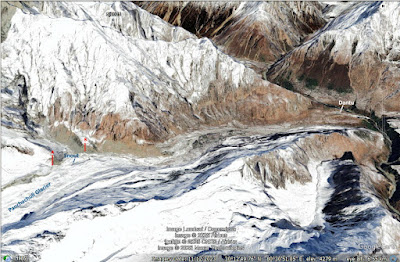Over the past few years I have been regularly visiting the Panchachuli Glacier in the Kumaon Himalaya. Accompanying me are a group of geology enthusiasts from all walks of life. This is an outreach effort I have undertaken in collaboration with Deep Dive India.
Every time I make it a point to walk to the glacier snout where the river Dhauliganga emerges from an ice cave. Every time my experience of approaching the glacial terminus is different. The Panchachuli Glacier is a shape shifter. I have to walk a little longer each time to reach the snout, negotiating the changing configuration of rubble mounds and streams.
I thought I would document the retreat of the snout over time using field photos from my visits beginning year 2017 and supplemented by Google Earth imagery going back to the year 2000. I won't keep you in suspense. The glacier snout has retreated by about 1 kilometer in the last 25 years. That is by 40 meters per year. But the rate has varied, with an acceleration in the past 8 years.
Let's begin with a synoptic view of the glacial valley.
The walk begins at village Dantu. It is about 6 kilometers to the present position of the snout. The red lines are edges of old lateral moraines. They are stable features and are easily recognizable in the satellite images. They are my fixed marker posts against which I will track the changing position of the snout. Distance to the snout in all images is estimated from marker post A.
Year 2000- Google Earth Imagery.
Notice the curvilinear cracks (white arrow) near the snout. The glacier retreats by slices of ices cleaving off these cracks. Between the two marker posts is a smaller glacial valley. Semicircular depressions and ponds have formed on the glacier surface due to thawing of the ice. The distance to the snout from A is about 1.3 kilometers.
Year 2012- Google Earth Imagery.
Distance to the snout from marker post A is 840 meters indicating a retreat of 460 meters in 12 years, averaging about 38 meters per year. The smaller valley still has a fair amount of ice accumulation.
Year 2017- Field Photo.
This was taken during my first visit from a high vantage point along the trail to "Zero Point", a popular trekking spot along an old lateral moraine.
Year 2017- Google Earth Imagery.
Between 2012 and 2017, the snout has retreated a further 120 meters, an average retreat of about 26 meters per year. The frontal part of the smaller side glacier is now showing signs of collapse. Pronounced curvilinear cracks have appeared and glacier retreat has left behind rubble mounds producing an uneven topography at the front.
Year 2023- Field Photo.
Taken from close to the 2017 vantage point.
Year 2023- Google Earth Imagery.
The snout is now just 280 meters from marker post A. This implies a retreat of about 430 meters between the years 2017 to 2023. The average rate of retreat is an astonishing 71 meters per year. There are signs of significant changes around the glacial terminus. The snout is now up-valley of marker post B. The smaller valley between the marker posts is almost completely ice free. A surface drainage has developed along this side valley and joins the main Dauliganga stream just downstream of the snout. The multiple small streams in the area is due to drainage finding its way around fresh mounds of rubble.
My most recent visit was earlier this month in May. Google Earth does not have imagery from 2025. But I will share a field photo taken from the high slopes looking down towards the snout.
The snout has retreated by tens of meters and is almost in line with marker post A, strongly suggestive of high rates of retreat persisting over the last couple of years. The area around the terminus is a degraded landscape with rubble heaps everywhere. We could not get very close to the ice cave this time due to time constraints but I assessed it would have been a more difficult passage negotiating the multiple streams and boulders.
The rates of retreat that I have estimated are a little higher than those made by geologists from other parts of the Himalaya. A Ministry of Earth Sciences press release from 2023 has shared some data on Himalaya glaciers. The average retreat rate for Ganga Basin glaciers is about 15 meters per year, while that for Brahmaputra Basin is about 20 meters per year.
A more detailed study of Gangotri, India's most famous glacier, shows a retreat rate of 20 meters per year. Significantly, the retreat accelerated in the past few years to about 33 meters per year, a pattern I too have observed for the Panchachuli Glacier.
Himalayan rivers provide water security for hundreds of millions of people in the Indian subcontinent. Glacial runoff contributes a timely and significant amount of water to these rivers. The Indian government is building and planning scores of dams in the Indus, Ganga, and Brahmaputra basins with elaborate arrangements of water use and water sharing with different stakeholders. Given the massive ice loss and changing climatic patterns, it is imperative that detailed feasibility studies of these projects in terms of both safety, and near, mid, and long term projections of water availability are carried out.
I'm putting up this final image taken in May 2025 from near the Dhauliganga stream looking towards the terminus.
It captures nicely the long term changes that have taken place. The blue line marks the top of the glacier. Fresh collapse has exposed shiny ice walls. The brown line above is the crest of an old lateral moraine, several hundred feet higher than the present day glacier surface.
Is there a better landscape to contemplate and appreciate climate change and the dynamic glaciers which have shaped our planet over past centuries?









